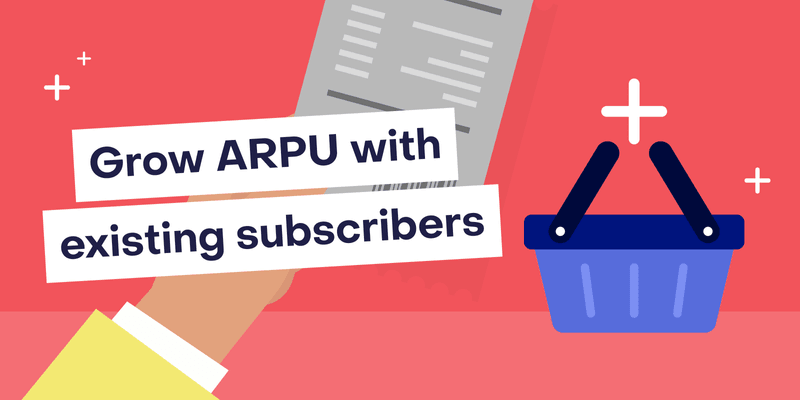Growth often slows for more established subscription apps from acquisition channels mature and conversion funnels are optimized. So how do you continue to scale?
The next stage of growth doesn’t come from finding more users, it comes from creating more value for the users you already have (and monetizing that value, of course).
Expanding product value helps in two key ways:
- Retention: by solving more problems and staying relevant in your user’s daily life, you reduce churn and increase subscriber lifetime value (LTV)
- ARPU: once new value is proven and desired, it can be tiered, bundled, or monetized — increasing average revenue per users (ARPU)
In practice, the line between retention and ARPU is thin. Value expansion often starts as a retention initiative, then evolves into a revenue driver once engagement and perceived value grow.
Before we dive into identifying opportunities to expand value for your existing subscribers, let’s take a look at examples from five leading subscription apps whose added value paid off.
5 app examples for expanding core product value
These mini case studies show how mature brands have extended their core product to unlock both retention and revenue growth, primarily through:
- Capitalizing on adjacent use cases and jobs-to-be-done
- Finding new audiences through new use cases
- Expanding frequency of relevance in users’ daily lives
- Adding new core value that can be monetized as premium
Read on for more detail, and some inspiration!
1. Headspace: from meditation to whole-person wellbeing
Headspace began as a meditation app but gradually broadened its focus to include sleepcasts, focus music, workouts, and therapy content. This shift positioned the brand as an entire, holistic wellbeing platform rather than a single-purpose meditation tool.
The expansion worked by extending Headspace’s relevance (and potentially deepened engagement) across more daily moments: sleep, exercise, focus, and stress management.
Over time, the company also introduced higher-priced tiers and enterprise partnerships, reflecting how a wider value proposition can support stronger monetization. For example, Headspace’s blog and press releases indicate that by 2023-24 the company was offering enterprise clients a single app integrating mindfulness, coaching, therapy and psychiatry, as well as launching direct-to-consumer mental health coaching.
Lesson: expanding into enterprise and higher-value, direct-to-consumer tiers is a clear route to widen value proposition, and can create the justification for stronger monetization.

2. ClassPass: from fitness access to lifestyle membership
ClassPass initially grew its subscriber base with access to boutique fitness-studios and classes. Today, the platform has shifted into selling far more than workouts; offering a broader lifestyle subscription covering wellness and self-care.
On its website, ClassPass now describes itself as “one app for all things fitness, wellness & beauty” and states that credits can be used for bookings at gyms, studios, salons and spas.
A 2018 article noted the addition of “an assortment of new wellness experiences including massages, facials, cryotherapy, float spas, infrared saunas”. Since then, wellness and beauty bookings reportedly became a major part of the business — at one point in 2021, non-fitness venues made up 55% of all listings in New York for ClassPass; massages in particular “became the most popular wellness activity”.
ClassPass is a great example of how a subscription service can expand into adjacent motivations to reach a new audience (e.g. from solely gym-goers to also self-care and beauty lovers) and increase usage frequency. By widening the scope of what can be booked with credits, ClassPass not only found new users, but increased the relevance of its membership across more parts of existing users’ weekly life.
Lesson: supporting higher engagement (more usage occasions) and deeper value for members will ultimately result in stronger retention, LTV, and new monetization paths (through premium plans, more credits, higher-value bookings).

3. Airbnb: from budget stays to curated experiences
Airbnb rose to success as a peer-to-peer marketplace for spare rooms. Since its launch in 2008, the platform has expanded beyond accommodation into categories such as curated online ‘Experiences’, luxury home rentals, and bespoke services allowing users to book chefs, trainers, massage therapists and more at their rentals.
In 2025 Airbnb announced a relaunch of its Experiences and introduced Airbnb ‘Services’. The evolution suggests the company is not simply scaling by adding more listings or new types of accommodation, but broadening what a “trip with Airbnb” can mean, making the brand relevant to more moments, more identities of traveller, and ultimately enabling higher-value bookings over time.
Lesson: broaden your offering around related use-cases to not only deepen engagement and relevance, but also open the door to increasing transaction size and revenue potential.

4. Duolingo: from language learning to the learning habit
Duolingo built its reputation on gamified, bite-sized lessons designed for language learning. Over time, however, the company broadened its scope: it introduced longer courses in subjects like maths and music, and more recently launched a chess course that uses puzzles and interactive matches.
This expansion appears to have been aimed at turning a language-learning habit into a more generalised learning habit. Rather than simply charging more up front, Duolingo has focused on increasing daily engagement and habit strength across multiple subjects first, then positioned itself to monetise this broader surface area of learning via upgraded subscription tiers and premium features.
The broader curriculum appears consistent with the strong financial momentum the company is reporting: 41% revenue growth, and rising paid subscriptions in 2025. Analyst commentary further suggests this adjacent-subject expansion is a key lever for driving higher ARPU.
Lesson: expand your habit loop into adjacent domains (from languages to maths, music, and chess) to boost retention first, then create the platform for increased ARPU once the concept is proven.

5. OpenAI: from chat to a daily co-pilot across work and life
ChatGPT launched in late 2022 as a conversational AI that people used for questions, ideas and simple creative tasks. With rapid expansion, the platform has broadened into a much wider set of everyday and professional use cases. ChatGPT is now being used across writing, coding, studying, analysis and business workflows.
OpenAI’s own product announcements reflect this widening scope. For example, ChatGPT can now generate and analyse files, troubleshoot code, create images, support team collaboration, and run custom agents built by users.
ChatGPT’s use now spans students, marketers, engineers, SMBs and enterprise teams. In many cases under the same Plus or Team subscription.
By expanding into more real-world contexts, ChatGPT appears to have evolved from a curiosity into a utility product, which helps support premium plans. Reporting shows that ChatGPT Plus reached around two million subscribers by early 2024 as use cases broadened.
Lesson: when a product expands into more daily use cases, occasional usage can turn into habit — and habitual use creates the foundation for stronger retention and pricing power.

Identifying your subscription app’s value expansion opportunities
Once a product reaches maturity, the question shifts from “how do we get more subscribers?” to “how do we create more reasons for existing subscribers to stay and pay more?”. The answer is pretty simple: make your app worth more. Give subscribers new features, new use cases, and new motivations to use the app.
Value expansion isn’t guesswork; the most successful companies, like the examples above, follow a recognisable pattern. Here’s four steps to identify your app’s next shift:
Start by mapping core and adjacent jobs-to-be-done
Every subscription product solves a primary job for users, but most users have several related needs surrounding that core job. For example, Headspace began by helping users target anxiety and relaxation — the next natural step was tackling sleep.
You can start by observing what people try to accomplish before, during, and after they use your product to reveal natural places to expand. These adjacent jobs usually become the clearest starting points for broadening value.
Alternately, look to competitors and the rest of the market. Duolingo was already the market leader for language-learning, but the ‘Education’ category of the App Store still showed other general learning apps. So it made sense for them to expand to other subjects beyond language.
Validate with behavioural and survey data
Not every adjacent idea is worth pursuing. The strongest signals come from your most retained users: what else do they repeatedly do, search for, or pair with your product?
Behavioral analysis often uncovers complementary apps, repeat patterns, or clusters of similar feature requests. Review mining can also be a valuable technique to identify new areas for expansion that you already know users are interested in. Surveys and interviews help confirm whether those patterns represent real unmet needs rather than edge cases.
Test expansion ideas through lightweight prototypes
Value expansion rarely begins with a full feature build. Many companies start with small, reversible bets: content pilots, limited betas, basic integrations or partnerships. These early experiments reveal whether users recognise the added value and whether it increases engagement.
If the signal is strong, the surface area can be expanded with more confidence, and you can consider putting monetization strategies in place (see below!).
Monetize only once the value is established
Most companies introduce expanded value as a retention lever before treating it as a revenue lever. While it’s tempting to put new features or use cases behind a paywall, hold off until users consistently engage with the new behaviour or app areas. Proven value supports pricing power; unproven value does not.
Once you have this proof, higher-tier plans, add-ons, or bundles feel far more natural to users, and far less risky to your retention..
Ready to expand your app’s value?
For established apps, expanding value is a natural next step once the core product and funnel have matured. It’s a retention lever first and an ARPU lever second.
There’s many ways to expand the value of your app and drive increased revenue per user; the examples and guidance in this article are just a handful of options at your disposal. But there is a general consistency among the apps that expand successfully: thoughtful expansion into adjacent use cases and audiences, backed by user research or interest, rather than a rapid reach in a new direction.
The longer users stay and the more needs you meet, the easier it becomes to justify premium pricing or new product lines later on.
In short: earn engagement, then monetize it. That’s how established subscription businesses turn retention improvements into sustainable ARPU growth.

